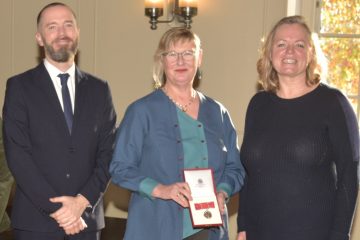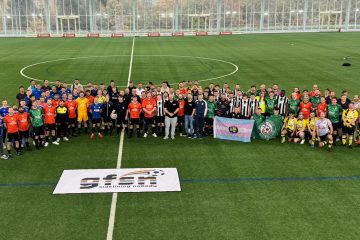Pride Month: Communicating LGBT+ inclusion in sport
June is a time for celebration, reflection and protest for LGBT+ people. How can sports organisations best show their support? Access Pride resources here – updated for 2024 – and discover how Sports Media LGBT+ can help you…
By Jon Holmes
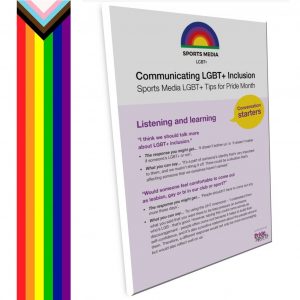
Pride Month is an ideal opportunity for governing bodies, organisations and clubs across sport to reinforce their commitment to LGBT+ inclusion.
June is always a special time for LGBT+ people. Many will mark Pride in 2024 by attending events that have been long in the planning.
Not all related events are held in June, due to reasons of geography, availability and logistics – for example, the 2024 Pride in London parade is being held on Saturday, June 29, while Manchester Pride is in late August.
Some sports NGBs have created impactful activities based around Pride, such as British Canoeing’s Paddling With Pride – the focus of a blog we contributed in 2023 to the Sport and Recreation Alliance website drawing on data about LGBTQ+ inclusion…
In recent years, Sports Media LGBT+ has delivered informative, educational webinars and workshops about how to communicate a message of welcome during Pride Month in the context of sport, at the invitation of organisations such as the Premier League Charitable Fund, the FA of Wales, the Sport and Recreation Alliance, and Aston Martin F1.
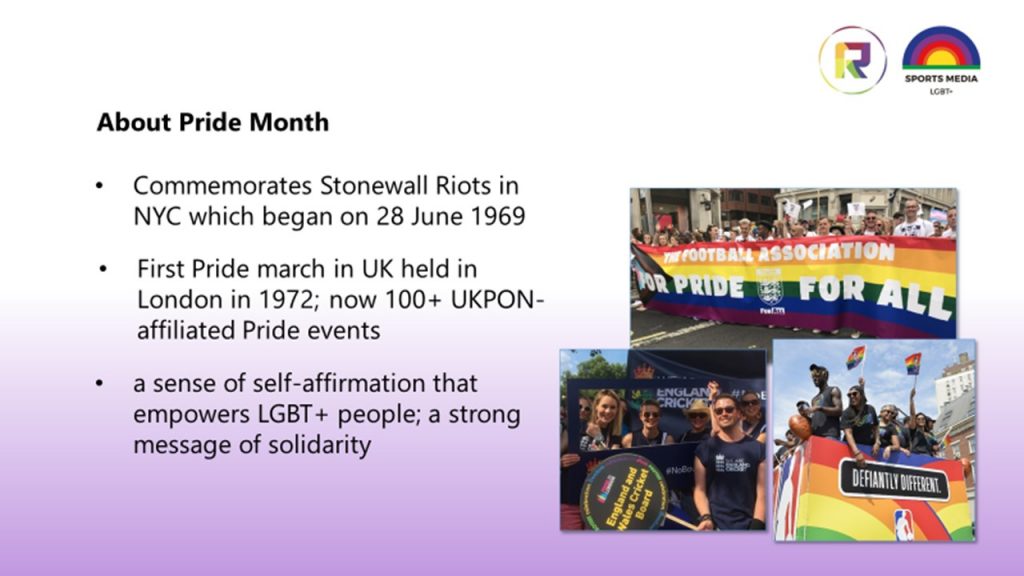
Often delivered in conjunction with our friends at Pride Sports UK, the aim of these sessions is to show how sports can talk about the importance of Pride to a broad audience, i.e. not just those people who are LGBTQ+.
This is one of many workshops and presentations we’ve given in recent years. In May 2023, we delivered ‘Preparing for Pride Month’ as part of the agenda at the Include Summit in Manchester, the UK’s biggest conference for ED&I in sports.
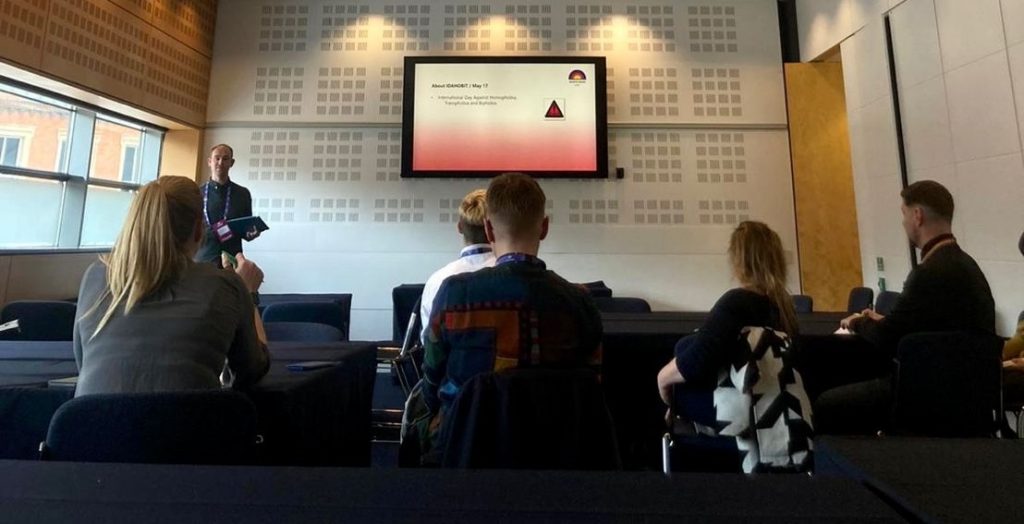

UPDATE – For 2024, we’ve again refreshed our Pride material – it can be adapted to suit a range of different sports and objectives.
Here’s a testimonial from LGBT+ in horseracing network Racing With Pride, who invited us to talk to a group of people from across the racing community. See events happening in June 2024 and beyond on our Calendar.
“Our ‘Preparing for Pride’ webinar was a huge success thanks to Sports Media LGBT+. Jon gave everyone the confidence to communicate about LGBT+ inclusivity while encouraging and challenging everyone to go beyond the basics. Many organisations across horseracing are now proactively planning their own activity for Pride month.”
Rose Grissell, Head of Diversity and Inclusion, British Horseracing Authority
“It was fantastic to see the level of engagement the webinar received from all corners of the horseracing industry. There is a genuine desire to further the sport’s understanding and activity in this area and the webinar has helped to give organisations the confidence to take the next steps in engaging more fully with Pride month and LGBT+ inclusion more broadly.”
David Letts, member of Racing With Pride and the Diversity in Racing Steering Group
It can be challenging for those in sports media and comms roles to talk about the equality, diversity and inclusion work that their organisations are involved in, and specifically, the roles played by lesbian, gay, bi and trans people in terms of creating content, influencing workplace culture, and providing representation.
However, it’s important to reassure LGBT+ people and allies internally and externally that they are valued. This sends out a positive message about the benefits of authenticity to both groups, and reflects well on the efforts of those responsible for ED&I.
The Sports Media LGBT+ Pride webinar was initially developed from a resources pack we produced in February 2020 titled ‘Rainbow Ready’ – a document of strategy advice and guidelines for anyone in a media and comms role in sport. This resource was updated for the Commonwealth Games in Birmingham in summer 2022.
We also produced a bespoke four-page document to help our media colleagues navigate their own path through Pride Month and produce a message that’s suitable for their sport. A big thank you to Jen Watts Design for bringing it to life!
Check out the document – it’s free to download and share…
SMLGBTTipsForPrideMonthYour Questions Answered
Below are some examples of questions posed during one of our webinars. If you’ve got any queries, please drop us a line at info@sportsmedialgbt.com…
“If you’re an LGBTQ+ inclusive club, how do you appeal to non-binary / transgender people without feeling like you’re singling them out?”
Non-binary and trans people are going to be looking out for those specific words within your comms, or variations on terminology – it’s only natural.
A great example of how to communicate this effectively is provided by Goal Diggers FC. The club states on social…
“We aim to make football available and accessible to all women and non-binary people, regardless of experience or ability.”
Goal Diggers FC
In the ‘About’ section of their website, club founder Fleur Cousens says simply: “The main aim of GDFC is to show that football doesn’t need to be gendered – football is a sport for everyone.”
Here’s some advice on what you can do to reach non-binary and trans people…
- Make sure a Google search for your club name and the words ‘non-binary’ and ‘trans’ produces a result that communicates a welcoming message
- Consider adapting your logo or some of the graphics that you use to incorporate the colours of the trans pride flag and/or the non-binary pride flag
- Invite someone in your club or your sport who is trans or non-binary to talk about their experiences in a blog post or short film which you can share across your channels or newsletter
“How can we engage people in the LGBT+ community who are Black / from diverse ethnic communities?”
This point was raised midway through our webinar, with images related to inclusive comms and personal stories up to that point having featured only white athletes (representation did subsequently follow). It’s true that there aren’t as many people who are LGBT+ and out in British sport who are also Black / from diverse ethnic communities, but this is changing. For example, the Athletics Pride Network – featured in our webinar – reflects the strong representation of Black athletes in track and field.
For a variety of reasons, people who are LGBT+ and who are Black / from diverse ethnic communities may feel less comfortable than their white counterparts about being visible. Recognising both this and your own objective to engage more with those communities, try reaching out to a relevant, established non-sports specific group in your area (Stonewall’s website has a great list) and ask them if you can pitch your club or project to their members.
Be clear about your reasons for wanting to engage more with different communities and make accessing a trial session or similar introductory experience as easy as possible for anyone who’s interested in learning more. Have an email template ready that you can adapt and send out; keep up the conversation through follow-up messages; and ensure your potential new recruits are added to mailing lists, group chats etc in a timely fashion.
“How do you deal with negative feedback towards trans athletes on social media? How should you reply? What terminology is best to use?”
Depending on the social media platform, this negative feedback could manifest in different ways – on Facebook, it could be negative emoji reactions as well as comments, for example.
Firstly, never react or reply in anger – your first response should be to consider hiding the written feedback; this doesn’t alert the person who posted, but does conceal the feedback from anyone else. If you’re on Twitter, you can also mute the user.
If that’s not working for you and the negativity is increasing, the next step to consider is blocking the user. This removes them from interacting with you completely. They will know you’ve done this so you need to think ahead. If the user clearly has very little influence on the social media platform, e.g. very few followers / is an obvious bot or troll, blocking is the best option.
Remember, unless you have a locked account (Twitter / X and Instagram), your reply – if you make one – will be visible to anyone. If a specific athlete is being discussed, try not to have them tagged into the post, particularly if the negativity is already escalating.
In all social activity on LGBT+ inclusion, we advise responding to positivity with positivity – this amplifies the welcoming messages and pushes negativity away. Check out this excellent Twitter / X thread by Christian Harrall-Baker, a social media consultant with LiveWire Sport…
Outside of elite sport, the participation of trans and non-binary people is likely to operate on a social model. Make sure you have a thorough knowledge of the applicable inclusion policy for your sport and be prepared to quote this if you make the decision to reply.
Opportunities for trans athletes in elite sport – particularly trans women athletes – vary depending on the sport itself, and policies are still evolving in line with academic research and sports science. You could be communicating on behalf of the governing body or sports organisation. If you feel you must intervene, we suggest moving the discussion towards the existing policy and away from the athlete or athletes in question. Study the policy carefully and be prepared to quote the terminology it uses.
“How do you get hold of trans guidelines within governing bodies, as some are there but people don’t know they exist?”
All governing bodies should make their trans inclusion policies available in the public domain. If you can’t obtain it through their website or an email enquiry, try seeking out help from the Sport and Recreation Alliance, and Pride Sports.
“What are some strong ways to mention one’s club is LGBT+ inclusive, without sounding like it’s virtue signalling?”
We believe the strongest way to demonstrate your club’s LGBT+ inclusivity is through communicating the lived experiences of your LGBT+ members and their allies. Invite them to share their assessments of how inclusive you are as a club and amplify their voices through your channels – blogs, podcasts, short films, and social media.
If you’re not able to do this for whatever reason, consider what evidence is available to you. Does your club have a connection with any LGBT+ organisations? What commitments have you made to inclusion – are these in writing and easily discoverable, such as through your website?
What campaigns or initiatives do you support e.g. Rainbow Laces, Football v Homophobia, Pride Month etc, and have you documented your support for them? LGBT+ people respond positively to all these signals – they communicate an understanding of what inclusion looks like, with substance and action that goes beyond virtue.
For people who react negatively and who question your intentions, remember that you do not need their approval to undertake LGBT+ inclusion work. Mentioning Pride or a similar theme is about more than mere sentiment when you’re able to demonstrate your own commitment to creating a welcoming environment in sport.
Thank you to Pride Sports UK and the Sport and Recreation Alliance for the opportunity to share advice on Communicating LGBT+ Inclusion.
Further reading…
‘Rainbow Ready’: Resources for Communicating LGBT+ Inclusion in Sport
Sports Media LGBT+ is a network, advocacy, and consultancy group that is helping to build a community of LGBT+ people and allies in sport. We’re also a digital publisher. Learn more about us here.

